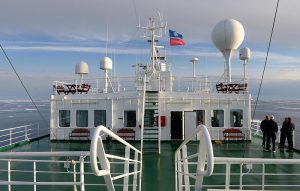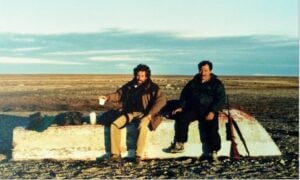
History
2014 Victoria Strait Expedition
This year's search is about much more than underwater archaeology. The Victoria Strait Expedition will contribute to northern science and communities.
- 1205 words
- 5 minutes
This article is over 5 years old and may contain outdated information.
History

Sir John Franklin was already a national hero, an explorer who’d led daring overland expeditions to the Canadian Arctic that captured the imagination of Victorian Britain. By the time the naval captain set out to seek the Northwest Passage, he’d been tested by decades of service to the Royal Navy. His third expedition, it was thought, would bring him even greater glory, claiming a great geographical prize for the United Kingdom. It was not to be.

On a previous Arctic journey, Franklin’s party had been reduced to eating the leather on their clothing just to survive. Franklin even ate his footwear, becoming known in England as “the man who ate his boots.”
This time around, his ships would be better provisioned. The specially outfitted HMS Erebus and HMS Terror carried enough supplies for three years at sea: beef, pork, flour, oatmeal, lemon juice and no fewer than 20,000 pints of soup. A library of 1200 volumes would ensure that not only were the sailors bellies full, but their minds stimulated. In the end, these books were almost surely burned for warmth.
When no word from the expedition had been received by 1847, search parties from Canada, the UK and the United States set out to find signs Franklin and his crew. Approaching Canada’s Arctic archipelago from both west and east, the first searches yielded nothing. Dozens more would follow, and great riches were offered for anyone who could find the crew. None found the Erebus or Terror, but through the shreds of evidence the searchers uncovered, a picture of what happened on the fateful voyage began to emerge.
As the expedition sailed toward Lancaster Sound at the northern tip of Baffin Island, whalers working the area were the last Europeans to sight the expedition. That winter, Franklin and his men wintered in a sheltered harbour at Beechey Island, more or less as planned. All but three men successfully endured that first Arctic winter, with a lonely cairn of stones left to mark their final resting place before the ships sailed again the next spring.

The expedition then picked its way through a labyrinth of rock and ice. Though headed south, they were on a course for some of the thickest sea ice in the world. It was here that disaster would strike. The Erebus and Terror became icebound near King William Island. The next summer, the ice didn’t melt enough to free the ships, and what was left of Franklin’s crew was forced to spend another winter in the locked in the ice pack.
By that time, Franklin himself had perished, and what was left of the crew would soon abandon ship and set out onto the ice in a vain attempt to stay alive. No member of the crew survived.
Franklin’s men are thought to have succumbed to a combination of exposure, starvation, scurvy and lead poisoning caused by soldering on tinned food or lead pipes in the ship’s water distillation system. Reports of cannibalism first emerged when Inuit told overland searcher John Rae of starving and desperate white men in 1854. Imperial Britain was scandalized. Cut marks on skeletal remains of crew members have since corroborated those gruesome reports, but the exact details of exactly what happened in the waning days of the lost expedition will never be known.
Are you passionate about Canadian geography?
You can support Canadian Geographic in 3 ways:

History
This year's search is about much more than underwater archaeology. The Victoria Strait Expedition will contribute to northern science and communities.

History
First official day of the 2014 search for Sir John Franklin’s lost ships

People & Culture
On April 12, Franklin enthusiasts had a rare opportunity to come together in the same room as The Royal Canadian Geographical Society presented their 2016 Can Geo Talks

History
Arctic historian Ken McGoogan takes an in-depth, contemporary perspective on the legacy of Sir John Franklin, offering a new explanation of the famous Northern mystery